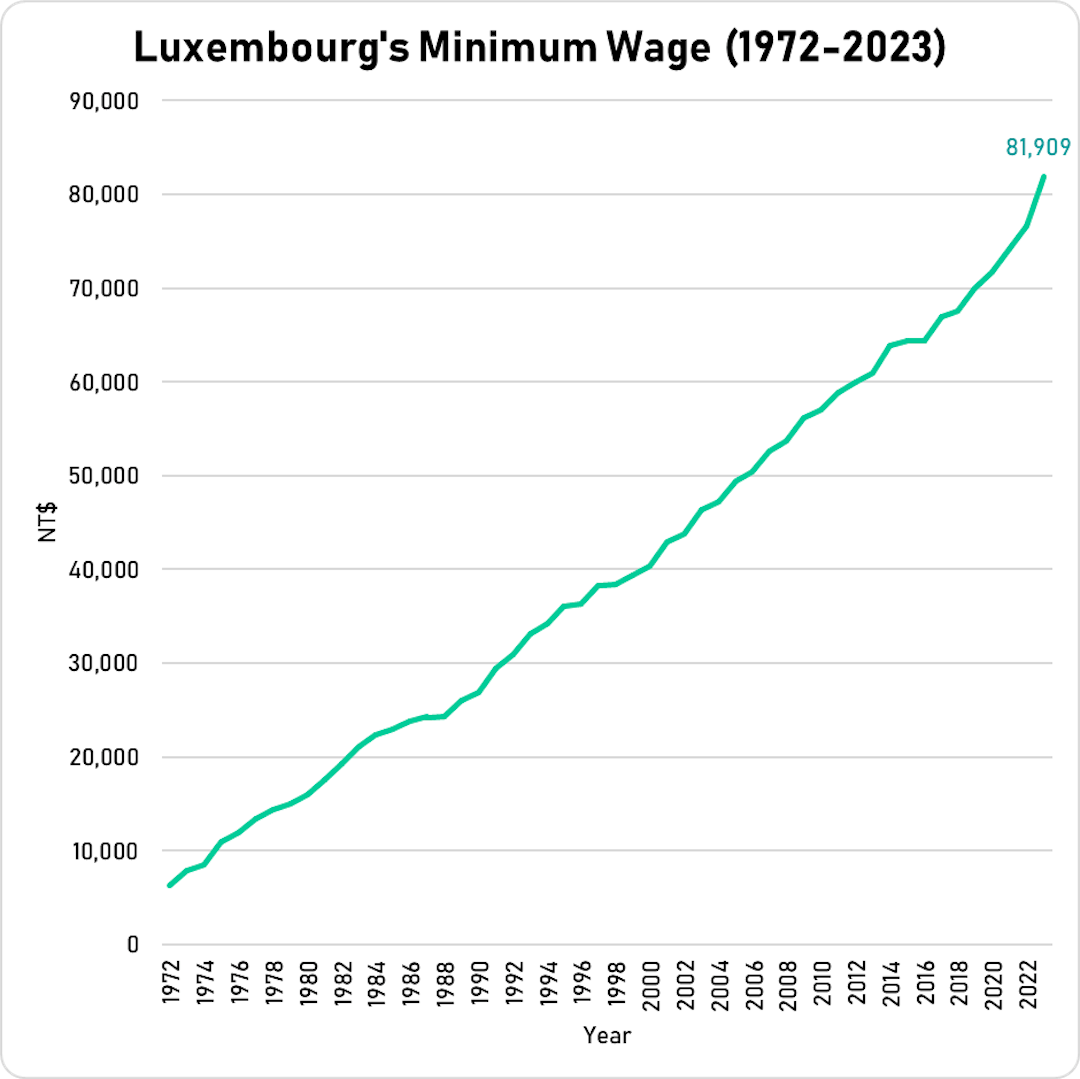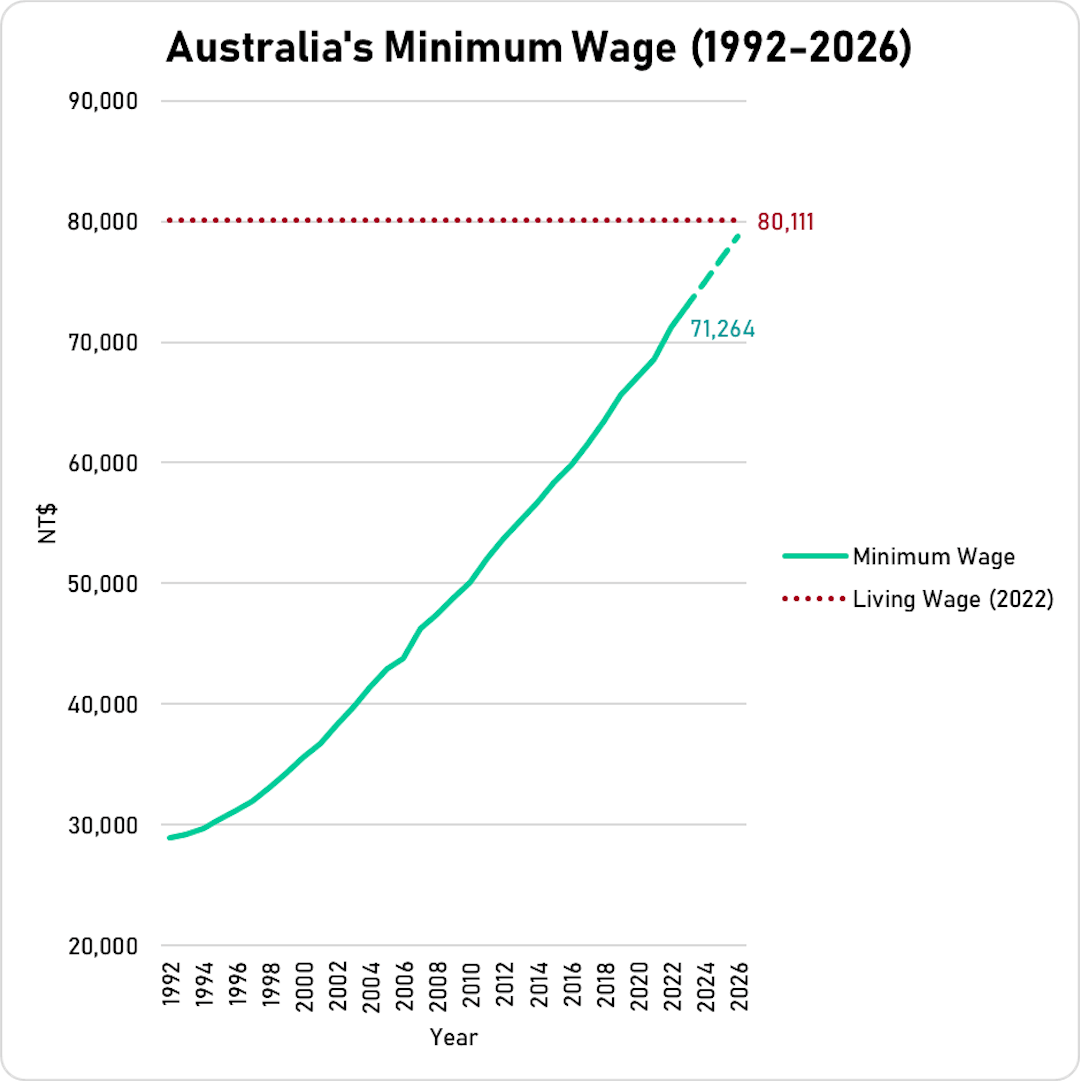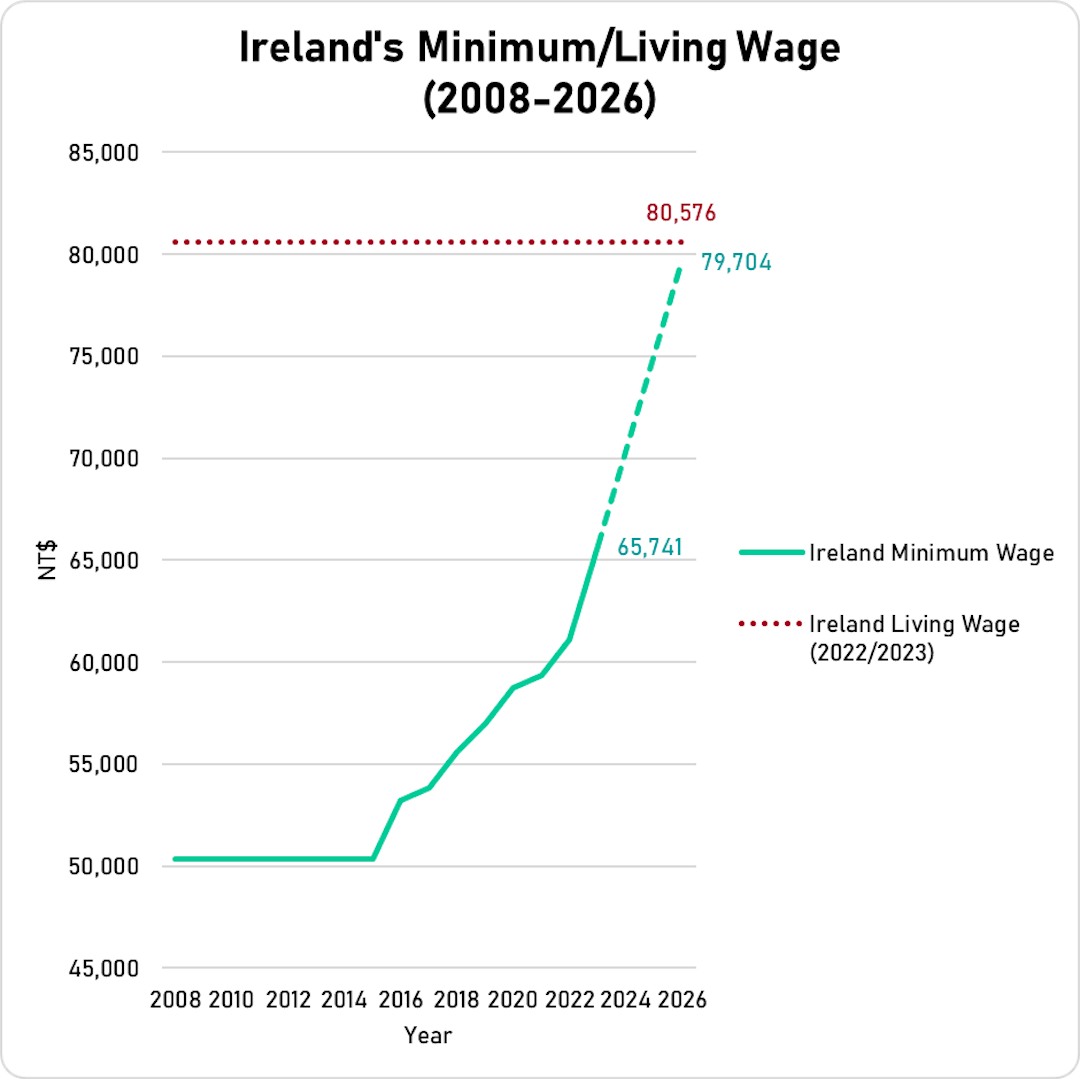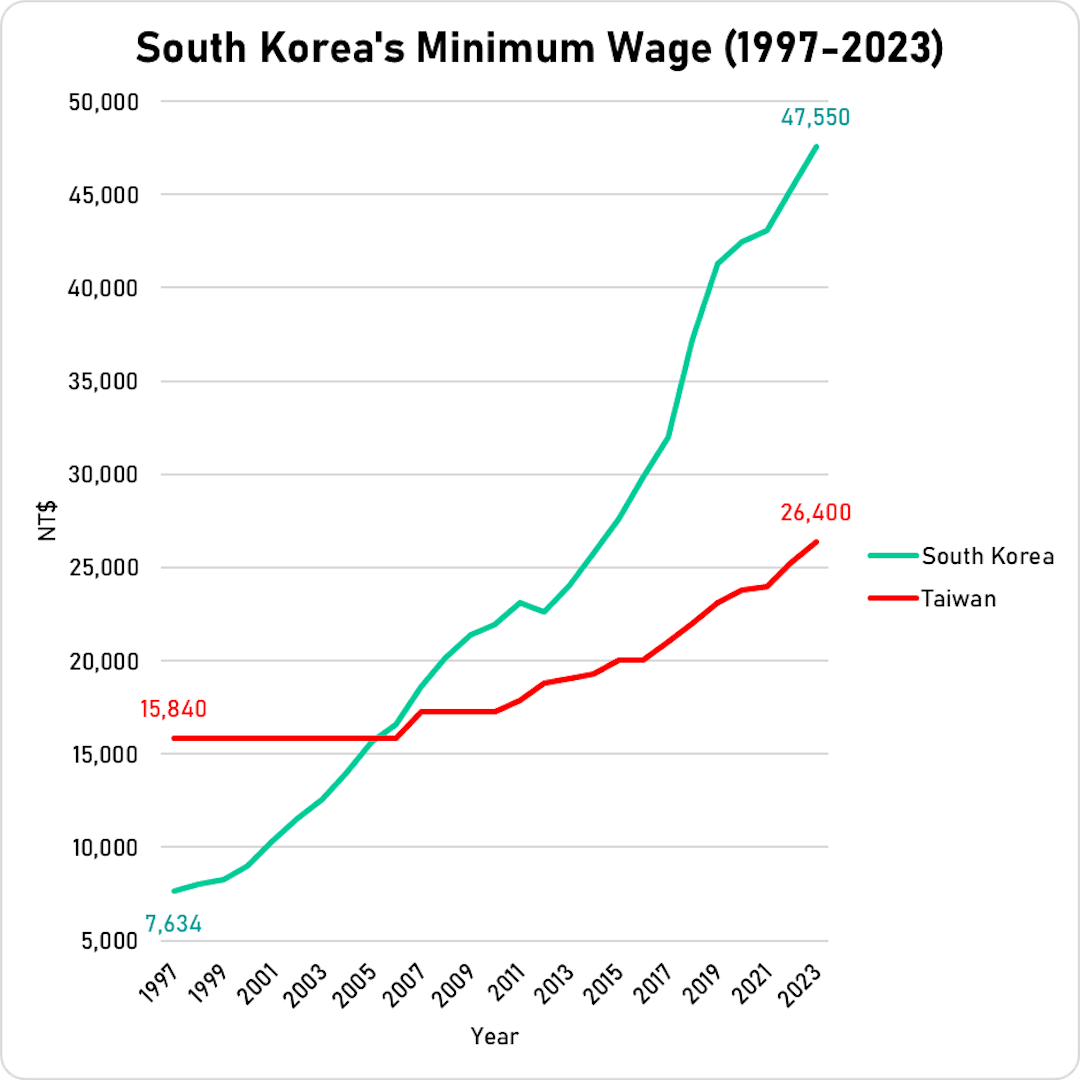
In a recent meeting, officials at the Basic Wage Commission said they’d look into the indicators that can be used to calculate the minimum wage under the minimum wage law.
In the first part of this article, I examine how other advanced countries determine the minimum wage. In the second part, I look at how much faster Taiwan could have grown the minimum wage if it had followed these countries.
Comparing Taiwan with countries with the world’s highest minimum wage
Luxembourg’s minimum wage, one of the world’s highest, has been increasing steadily and consistently (as seen in the chart below). Adjusted in line with the evolution of the cost of living, the minimum wage ensures citizens a basic but decent level of living.
Luxembourg developed a cost of living index based on a basket of goods comprising 19 basic items that reflected the spending needs of a family of two adults and three children. Under this system, every 2.5% rise or decline in the index triggers an adjustment to the minimum wage at a similar rate.
Since 1999, the basket of goods has been adjusted every year to reflect the spending habits each year, and the index now includes about 8,000 goods and services across 255 categories, including housing, energy, household appliances, and clothing.
The index is calculated and published monthly by Luxembourg’s National Institute of Statistics and Economic Studies (Statec), and its effect on wage growth applies to both private and public sector employees. By contrast, in Taiwan, public sector workers tend to be paid higher and more adequate wages and private sector workers earn inadequate wages.
Under Luxembourg’s system, the minimum wage has grown to NT$81,909 today, the highest nationally-defined minimum wage in the world. It has tripled since 1990 and doubled since 2000.
With global food prices reaching a record high in 2022, Statec expects Luxembourg’s minimum wage to be increased for a third time in the third quarter of this year, following increases in February and April.
Without such clear standards, Taiwan’s Basic Wage Commission could arbitrarily decide to hold off increasing the minimum wage. In the recent meeting, the Commission announced an increase would be discussed in the third quarter of the year, but Taiwan has seen one of its highest inflation rates in 14 years. Meanwhile, dining out costs have grown by 5.77%, the highest since 2008, and maintenance costs have grown by 5.82%, the highest since 1995.
Australia used to have a wage indexation system. A court calculated a basic wage considered fair and reasonable “based on the ‘cost of living’ for a family of five to be enough to feed, house and clothe them in ‘frugal comfort.’” At that time, the minimum wage was also automatically adjusted in line with the cost of living.
While the wage indexation system has been replaced by a formalized minimum wage system, Australia continues ensuring that the minimum wage meets the workers’ cost of living. An adequate level of minimum wage is known as the “living wage.”
The Fair Work Commission, Australia’s independent workplace relations tribunal responsible for setting the national minimum wage, commissions the Social Policy Research Centre (SPRC) at the University of New South Wales to calculate the living wage, or the budget necessary for healthy living standards. The aim of such a standard is to “ensure that each individual is able to achieve levels of consumption (of food, clothing, medications, transportation, personal care, and so on) and participation (in lifestyle, exercise and social activities) that are consistent with healthy living.”
Through focus groups from different family types, the SPRC identifies the items that constitute the basic needs of healthy living standards – food, personal care, clothing and footwear, recreation, household goods and services, health, transport, education, housing, and other discretionary items (such as alcohol consumption, smoking costs and overseas travel, etc.) – and come up with a budget required for such living standards. The budget is reviewed on an annual basis, and is updated to correspond to increases in the cost of living.
According to the SPRC, a single adult working full-time requires A$891 (NT$18,436) per week or NT$80,111 per month to maintain a minimum standard of living in 2022 (as can be seen at the red dotted line in the chart below).
Australia’s current minimum wage is NT$71,264 a month, and based on the current rate of growth, it would reach NT$80,111 in about three years.
Both Luxembourg and Australia have been steadily and consistently increasing the minimum wage in tandem with the cost of living.
Taiwan had been consistently increasing the minimum wage until the 1997 economic crisis. If the minimum wage had continued growing as in Luxembourg and Australia, it could have potentially reach close to NT$60,000 a month today (as can be seen in the red dotted line in the chart below).

Comparing Taiwan with other countries which are also suppressing wages
Living wage is being adopted in more and more advanced countries.
In 2001, Citizens UK started a living wage campaign in the United Kingdom, based on the idea that “all working families need, and deserve, a wage that covers the cost of living and meets everyday needs.” In 2016, the U.K. government decided to replace the minimum wage system with the living wage, allowing the minimum wage to increase at a faster pace. From 2009 to 2015, the U.K.’s minimum wage grew by an average of NT$922 a year, but since 2016, it has grown by NT$3,095 a year on average. This year, due to escalating food prices, the minimum wage has even grown by NT$6,123.
The goal of the national living wage in the U.K. is to ensure the minimum wage reaches 66% of median wage by 2024.
Citizens UK pointed out that a real living wage should be calculated “according to the cost of living, based on a basket of household goods and services.” The basket of goods used for this calculation is obtained from the Minimum Income Standard (MIS) research conducted by the Centre for Research in Social Policy (CRSP) at Loughborough University, which includes food, alcohol, clothing, utilities, household goods and services and other related costs, personal goods and services, childcare, travel costs and motoring, social and cultural activities, as well as rent or mortgage. Of note, the CRSP pointed out, “A minimum standard of living in the UK today includes, but is more than just, food, clothes and shelter. It is about having what you need in order to have the opportunities and choices necessary to participate in society.”
Similar to Australia’s SPRC, the U.K.’s Centre for Research in Social Policy also conducts focus groups to identify the relevant items for the minimum needs of individuals, and to calculate the corresponding budgets required for an adequate standard of living. These budgets are also updated annually to reflect consumer price increases annually.
In the U.K., the living wage is £10.90 (NT$417) per hour, or NT$72,548 a month.
The current national living wage stands at NT$69,353 a month, and based on the current rate of increase, the minimum wage should reach the living wage by next year (as can be seen in the chart below).
In both Australia and the U.K., as the minimum wage has been increasing sufficiently in recent years, it will soon reach the level of the living wage which guarantees a decent standard of living.
Since the implementation of the living wage in the U.K., there have been studies conducted to evaluate its impact on the economy. It has been found that the faster increase in the minimum wage didn’t result in higher unemployment. Instead, worker turnover lowered as “the bad jobs [became] better” with higher wages. Meanwhile, workers became more productive and businesses could reduce costs on recruitment and training. In fact, an increase in the living wage led to an increase in wages for workers at other wage levels, as businesses “attempted to preserve wage structures within their organisation”, and the quality of jobs has also improved.
The living wage was also found to have a negligible impact on inflation — a 10% increase in the minimum wage only increased consumer prices by 0.23% to 1.1%.

A clear multi-year plan to increase minimum wage
Like Taiwan, Ireland’s minimum wage did not grow at all for seven years, from 2009 to 2015, which kept it below the level needed to maintain a basic standard of living.
Last year, Ireland’s deputy prime minister, Leo Varadkar, announced a four-year plan to increase the minimum wage to 60% of median wage by 2026. As a first step, it increased the minimum wage by a dramatic NT$4,654 this year, to NT$65,741 a month. It is expected that the minimum wage will be increased to €13.70 an hour in 2026, or about €2,381 (NT$79,704) a month. Varadkar said the next step would be to increase the living wage to 66% of median wage.
Ireland’s plan comes after the European Union decided last year to establish a framework on minimum wages, which requires European Union countries to implement plans to ensure adequate minimum wages, one of which is to increase the minimum wage to 60% of median wage.
Another EU recommendation to ensure adequate minimum wages is to calculate the minimum wage based on a basket of goods indexed to inflation.
As in the U.K. Ireland’s Living Wage Technical Group was set up in 2014 to calculate a real living wage based on a basket of goods. The group pointed out that a living wage should be based on a “standard of living which meets physical, psychological and social needs, at a minimum but acceptable level,” and that it should be based on a “consensus on what members of the public believe is a minimum standard that no individual or household should live below.”
According to research, a real living wage of €13.85 (NT$464) an hour, or NT$80,576 a month, will be enough for a resident in Ireland to maintain a decent standard of living. Based on the current national living wage plan, the minimum wage will reach the living wage as the government planned, by 2026.
Germany is another country which has significantly raised the minimum wage in recent years to ensure a living wage for workers. Like Taiwan, Germany is a manufacturing powerhouse, and the minimum wage has long been suppressed to reduce production costs. In response, the Scholz government decided to dramatically increase the minimum wage to ensure a decent standard of living for workers.
In 2018, based on the German government’s calculation, the minimum wage would need to be raised to €12.63 (NT$423) an hour or NT$74,479 a month, so that workers would be able to receive an old age pension at a level above basic security. German labor unions at that time called for the government to increase the minimum wage to €12 an hour, which the new government finally did last October, after it came into power. The government decided to increase the minimum wage to €12 an hour or €2,086 (NT$69,813) a month, as it is determined to be 60% of the current median wage. This is massive 22.2% increase in its minimum wage.
Due to the escalating food prices, according to the Social Association Germany’s (SoVD) calculation, the minimum wage would need to rise to €14.13 an hour or €2,340 (NT$78,315) a month this year to offset inflation. Germany’s Minister of Labour and Social Affairs Hubertus Heil also said that he expected the Minimum Wage Commission to increase the minimum wage to €14 an hour, or €2,318 (NT$77,594) a month.
Based on the expected increases, Germany’s minimum wage is likely to reach the living wage of NT$78,315 this year.
On the rationale for spiking up the minimum wage, the ruling Social Democratic Party explained that the higher minimum wages has strengthened domestic demand and boosted the domestic economy, while also enabling the German economy to be more productive. Heil also emphasized the need for more respect for hard work, adding that employers cannot pay stingy wages and live comfortably while workers slave away under lousy conditions.
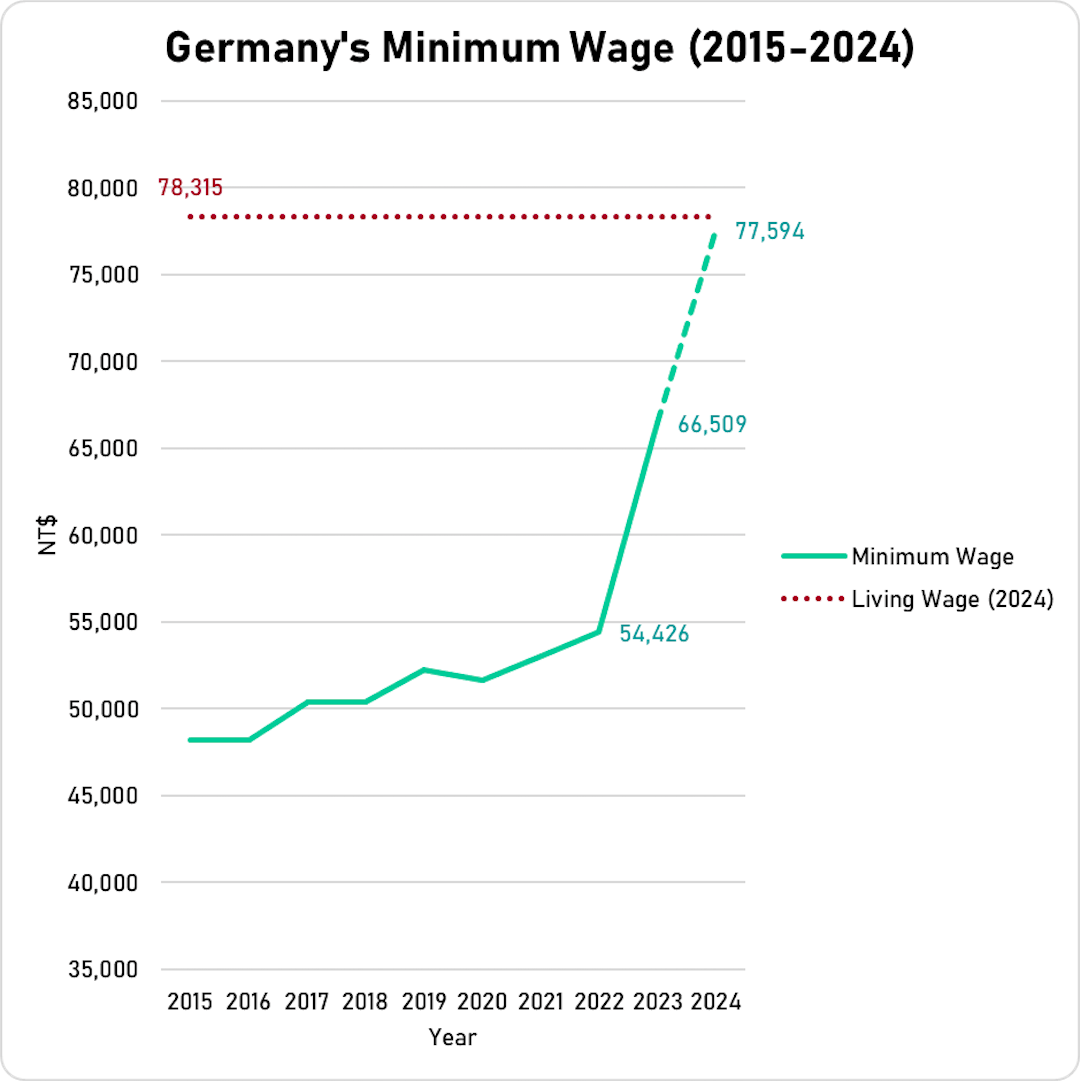
Singapore’s six-year plan to increase wages
The Singapore government had resisted calls to implement minimum wage until 2015, when it finally introduced minimum wages at a sectoral level for resident workers. The first minimum wage was introduced for the cleaning sector in 2015, followed by the security sector in 2017.
But these wages were as low as the minimum wage in Taiwan. The minimum wage for cleaning workers was only S$1,000 (NT$23,109) a month and for the security sector it was only S$1,100 (NT$25,420). Taiwan’s minimum wage is already inadequate for its cost of living, so one can imagine how much worse it was for Singapore’s workers.
In the last two years, Singapore finally decided to implement a six-year plan to increase minimum wages at a faster rate.
In the cleaning sector, the minimum wage will be nearly doubled from S$1,312 (NT$30,319) a month in 2022 to S$2,420 (NT$55,924) in 2028. From 2024 to 2028, the minimum wage will be increased by S$170 (NT$3,929) every year in order to achieve the target.
In the security sector, the minimum wage will be increased by a much larger extent—by 2.5 times from S$1,442 (NT$33,323) a month in 2022 to S$3,530 (NT$81,575) in 2028. The minimum wage would be increased by a whopping S$1,000 (NT$23,109) in 2024, followed by annual increases of S$220 (NT$5,084) until 2028. In other words, in 2024 alone, the minimum wage of security workers will be increased by 60.61%.
In the other sectors, like the lift and escalator sector and the waste management sector, the minimum wages also saw similar rates of growth, and will be increased to S$3,080 (NT$71,176) and S$3,160 (NT$73,024) a month in 2028, respectively, increasing by S$210 (NT$4,853) and an average of S$201 (NT$4,645) a year from 2024 to 2028.
Prior to the government’s six-year plan to increase wages, researchers from Singapore’s two largest universities had released a report in 2021 on the living wage.
Based on the methodology developed by the CRSP at Loughborough University in the United Kingdom, the researchers conducted focus groups with participants from diverse gender, ethnic and socioeconomic backgrounds, in order to identify their basic living needs and the corresponding budgets. Instead of using housing rents for their living wage calculations, the researchers used housing mortgages as “more than 80% of residents live in public housing, among whom more than 90% are owner occupiers” who paid mortgages on their homes, the researchers said.
According to their calculation, Singapore’s monthly living wage is S$2,906 (NT$67,155) in 2021, based on expenditures for food, clothing and footwear, transport, housing and utilities, housing furnishing and equipment, health, communication, educational services, recreation and culture, and other miscellaneous goods and services.
Based on the government’s six-year plan, most of the sectors would see the minimum wages reach the living wage in the next three to five years between 2026 and 2028. For workers in the cleaning sector, this is likely to happen in 2031, if wages continued to grow at the current rate.

Comparing Taiwan with countries at a similar stage of economic development
Taiwan’s minimum wage grew at a consistent pace in the 1980s and early-1990s before being suppressed after 1997. A comparison with countries at a similar stage of economic growth shows how far Taiwan’s wages have fallen behind.
South Korea and New Zealand had a GDP per capita closest to Taiwan’s in the 1990s. In 2001, Taiwan’s GDP per capita ranked 35th at US$13,357 while New Zealand’s GDP per capita ranked 34th at US$13,669 and South Korea ranked 38th at US$11,563.
In the 1990s, New Zealand faced the same problem as Taiwan when it came to the minimum wage. It had been kept low for a long time. This is when New Zealand decided to start raising the minimum wage at a faster rate. From 2002 to this year, the monthly minimum wage almost tripled in the last two decades, growing from NT$26,568 to NT$75,957.
Just as in the other countries mentioned above, the living wage campaign was launched in 2012 in New Zealand by local groups, following which the first living wage was calculated in 2013. The Living Wage Movement Aotearoa NZ defines the living wage as “the income necessary to provide workers and their families with the basic necessities of life,” and it “will enable workers to live with dignity and to participate as active citizens in society.”
The expenditure categories used in the living wage calculations include food, clothing and footwear, housing rent, household contents and services, household energy, health, transport, communication, recreation and culture, education, as well as miscellaneous goods and services, in addition to tax.
The living wage is calculated every five years, and adjusted annually for inflation. In 2017, New Zealand’s living wage was determined to be NZ$20.20 an hour. In the same year, when the Labor Party came into power, the new government promised to increase the minimum wage to NZ$20 an hour within four years, by 2021.
This year, according to calculations by the Living Wage Movement, the living wage should be NZ$26 (NT$371) an hour, or NT$86,999 a month. Based on the current rate of growth, New Zealand’s minimum wage should reach the living wage within three years.
Like New Zealand, South Korea started speeding up minimum wage rise after 2000, resulting in its GDP per capita overtaking Taiwan.
Since 2000, South Korea’s monthly minimum wage has increased by 5 times, from NT$9,024 to NT$47,550. Annually, from 2001 to 2009, South Korea increased the minimum wage by an average of 10%, and from 2013 to 2019, the minimum wage increased by 9%. In 2001 and 2018, South Korea’s minimum wage saw record increases of 15.10% and 16.38%, respectively.
In comparison, over the same period, Taiwan’s monthly minimum wage increased by only 1.67 times, from NT$15,840 to NT$26,400.
In 1988, Taiwan’s minimum wage was three times higher than South Korea’s, and in 1997, it was twice as high. But the tables have now turned. Today, South Korea’s minimum wage is almost twice as high as Taiwan’s.
The minimum wages in Australia, New Zealand, and South Korea have been increasing at a similar trend, but Taiwan’s minimum wage has experienced minimal growth. Australia is included in this comparison because it also had a GDP per capita more similar to Taiwan’s in the 1990s than other advanced countries. Australia’s steady and consistent minimum wage growth has made it one of the richest countries in the world today, while with wages stagnating, Taiwan lost its potential and saw much lower household consumption, profits and economic growth.
If Taiwan’s minimum wage had grown at a similar pace as the other countries corresponding to its cost of living, it could have grown to about NT$60,000 a month, or over two times higher than it is today.

Some might argue Taiwan’s cost of living is lower than these countries, including Australia, and higher increases to the minimum wage might not be necessary.
But according to Numbeo’s cost of living index, the cost of living of Australia, New Zealand, and South Korea, as well that of the U.K., Ireland, and Germany, is only about 1.1 times to 1.4 times that of Taiwan.
In comparison, the minimum wages in those countries are about 2.5 times to 3 times that of Taiwan. South Korea’s minimum wage is about 2 times higher than Taiwan’s.
In other words, Taiwan’s minimum wage is much less adequate for its cost of living.
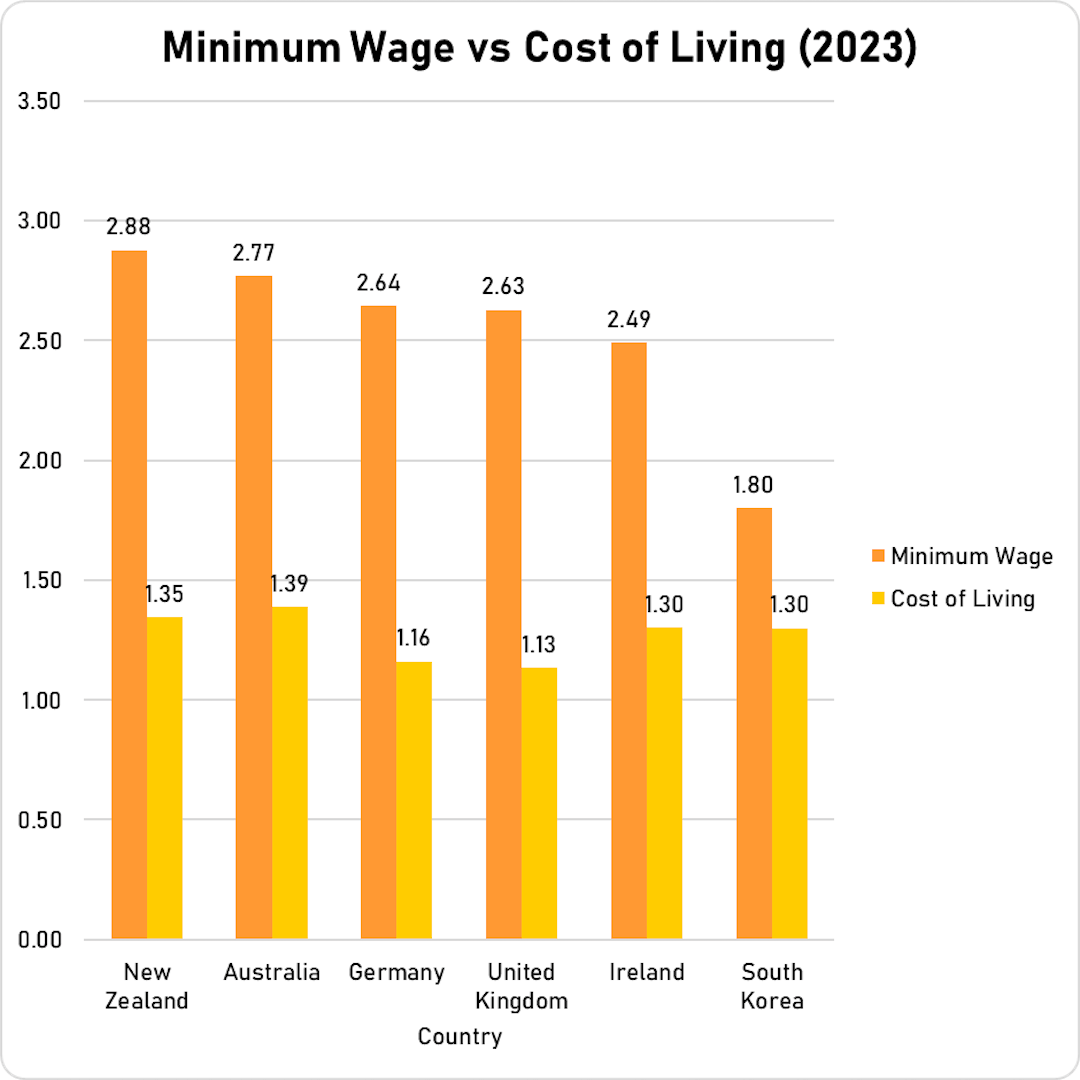
To be on par with these other countries based on the cost of living index, Taiwan’s monthly minimum wage should be over NT$35,000 if pegged to South Korea, and about NT$50,000 to NT$60,000 if pegged to the remaining countries.
As seen in the previous chart, these are the amounts that Taiwan’s minimum wage would have grown to if it had continued growing in tandem with Australia, New Zealand, and South Korea.
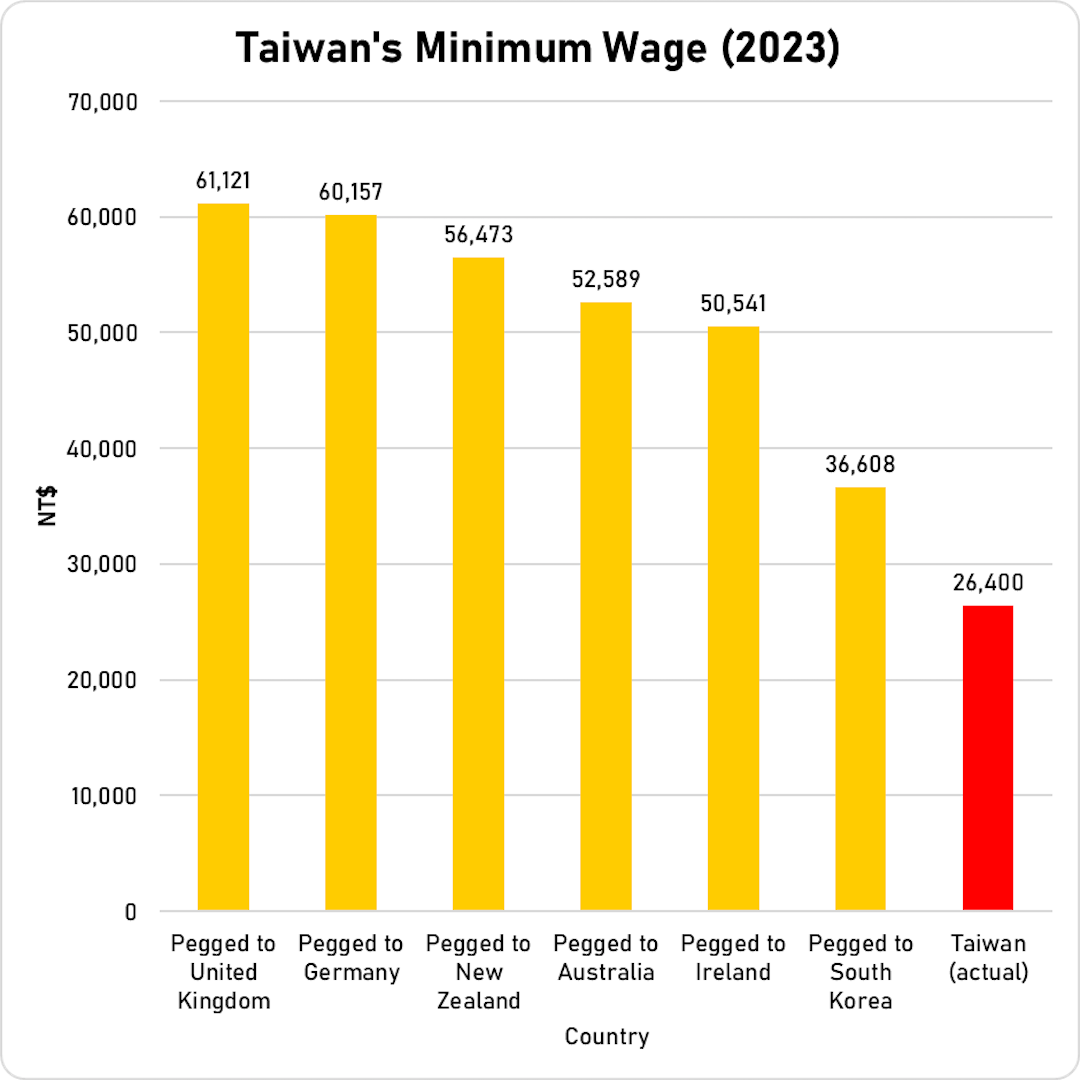
In many advanced countries, living wage movements have been launched to calculate the minimum income needed for a basic standard of living. The living wage needs not only to allow people to afford basic necessities such as food, clothing, and shelter, but to also ensure the psychological needs are met.
In order to achieve a living wage, many countries have been rapidly increasing the minimum wage. In Germany, the minimum wage increased by as much as 22.2% this year, while security workers in Singapore will see their minimum wage increase by over 60% next year. In South Korea, the minimum wage has been increasing by an average of 9% to 10% almost every year since 2000.
Based on the current rate of minimum wage growth, the minimum wages in the U.K., Germany, Australia, and New Zealand would reach the current living wage standards within the next one to three years. In Ireland, the government has implemented a four-year plan to raise the minimum wage to the level of living wage, while Singapore’s six-year plan should enable the majority of low-wage resident workers to earn a living wage by 2028.
By comparison, Taiwan’s government over the last two decades has not bothered to develop a strategy to ensure a living wage for workers. The Minimum Wage Act, which President Tsai Ing-wen promised to enact to better align the minimum wage with the living wage, has still not seen the light of day, and its introduction has been pushed back over and over again.
Taiwan’s cost of living is only about 10% to 25% lower than the other countries in this comparison, but its minimum wage is 50% to 65% lower. Taiwan’s minimum wage is thus severely inadequate for its cost of living, and workers are sorely underpaid.
If this goes on, Taiwan’s wages will fall further and further behind what is necessary for a basic standard of living, as consumer prices keep escalating. Low wage growth have led to the stagnation of household consumption and profits of domestic businesses relying on such consumption.
Given that Taiwan’s economy is contracting due to the declining global demand for its manufacturing and industrial production, it is now even more important for Taiwan to reorient itself and invest domestically. But before that, Taiwan should implement a clear plan to increase wages and improve work environments.
READ NEXT: Excessive Housing Speculation Is Weakening Taiwan’s Economy and Society
TNL Editor: Bryan Chou (@thenewslensintl)
If you enjoyed this article and want to receive more story updates in your news feed, please be sure to follow our Facebook.
